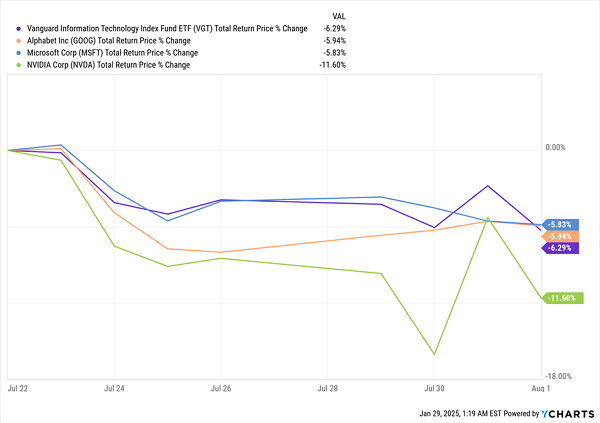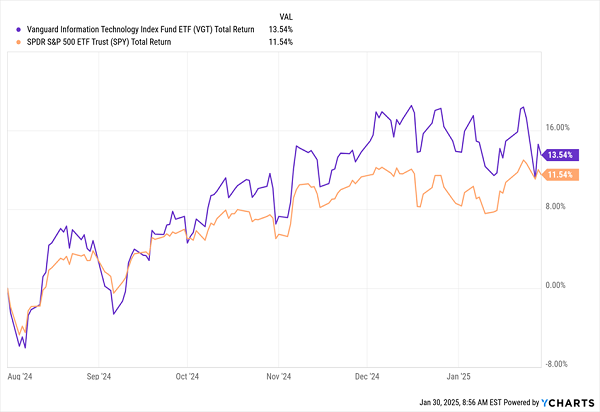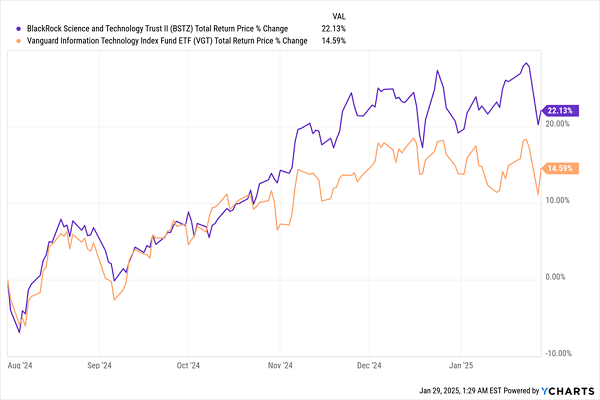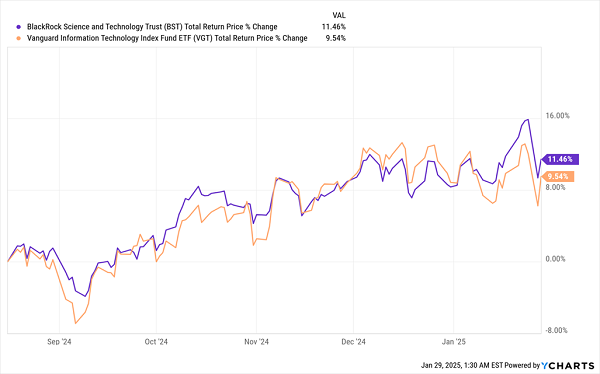Here’s my take on the DeepSeek selloff we saw last week: It’s a buying opportunity, especially for income investors.
(I wrote a bit about this in last Thursday’s article. Since the market has rebounded a bit since, we’re going to talk about it more today. A preview? It’s not too late to buy the dip.)
Income Investors: 2, Speculators: 0
Why do income investors hold an edge here? Because they have a chance to buy NVIDIA (NVDA) and other AI stocks, including some private-equity firms few people have access to, through closed-end funds (CEFs).
Tapping the selloff this way gives us two key benefits:
- Big dividends—the two funds at the heart of our strategy yield an average 10.4% when we buy them as a set.
- Extra discounts. If you’re a contrarian who thinks this selloff is already providing a good deal, then these funds let you build on that, since they’re both trading at discounts to the value of the stocks in their portfolios now.
The two funds in question—the BlackRock Science and Technology Trust (BST) and BlackRock Science and Technology Term Trust (BSTZ) are the two funds we’re focusing on here. (Both holdings are covered in depth in my CEF Insider service.)
They work well when bought as a pair because they have different mandates: BST focuses more on the big caps of the tech world, holding stocks like Alphabet (GOOGL), Microsoft (MSFT) and NVIDIA.
BSTZ holds some of those, as well, but also has smaller companies and private-equity firms focused on growth. That lends itself to more upside, but also more volatility—something BST, with its larger cap focus, helps us address.
To really get at the opportunity we’re looking to tap into here, let’s talk a bit more about DeepSeek and what it means for AI and the tech sector more generally.
The “Basic” Thinking That Sent NVIDIA and Friends Tumbling
Essentially, DeepSeek, which originated in China, was allegedly developed and trained for only $6 million. It’s now being offered as an open-source model essentially for free.
With a cost of $0 for this AI tech, the reasoning goes, there’s no reason to spend billions on AI from companies like OpenAI or others whose stocks soared on the tech last year. Those include Alphabet, Microsoft and NVIDIA, all of which tanked on Monday, with NVIDIA, maker of the chips that underpin AI, falling 17%.
Then, on Tuesday, the market erased much of its losses. NVIDIA has more room to recover, though there could be short-term choppiness as investors debate what all this means.
So, what should we make of this whole situation?
Perhaps the biggest takeaway is that AI is critical to the stock market, and even a whiff of things going amiss could cause a reflexive selloff.
The word “reflexive” here is key, because the selloff really didn’t make much sense. Free AI tools lower capital expenditure from businesses paying AI providers like OpenAI. That’s obviously bad for OpenAI and possibly Microsoft, which has invested almost $14 billion into OpenAI. Of course, that $14 billion is less than one-half of one percent of Microsoft’s market cap, so it’s really not that big of a blow.
Maybe it’s bad for Alphabet? That doesn’t make much sense, either, as Alphabet has been giving away many of its AI tools to ensure people keep using Google services, like search. So it isn’t really a direct competitor to DeepSeek.
And NVIDIA? That stock’s selloff was the most egregious, and not because it was the biggest. Thing is, free AI tools mean people will use more AI. And since lower prices increase demand for a product, the more AI demand there is, the more demand there will be for NVIDIA chips in the long run. DeepSeek’s new chatbot should’ve caused NVIDIA shares to rise, not fall.
Still, these stocks fell because this was a new story, and new stories create fear, which causes panic selling. Which is why we saw investors buy NVIDIA shortly after.
It’s not too late to join them—and as mentioned, BST and BSTZ are great avenues to take here. Especially when, in the case of NVIDIA, we were in this same situation just six months ago.
History Rhymes
Back in July 2024, fears that both President Biden and Donald Trump would impose controls on NVIDIA selling chips to China caused the stock to fall 12% that month, with almost all of the drop coming in a little more than a week (shown below).
“DeepSeek Dip” Looks a Lot Like Tech’s July Plunge

Other big tech names—like Alphabet (in orange) and Microsoft (in blue), as well as the Vanguard Information Technology Index Fund ETF (VGT), a reasonable proxy (in purple)—were dragged down alongside NVIDIA.
Anyone who bought that dip did well, as all of these stocks have recovered since, and helped drive tech (again measured by VGT, in purple) to outperform the S&P 500, even after last week’s selloff.
Tech Returns to Its Throne

That’s likely why some investors pounced on the DeepSeek–driven selloff.
BST and BSTZ: 2 Smart “Delayed Reaction” Plays on DeepSeek’s Arrival
Which brings us back to BST and BSTZ, and the opportunity they give us to “lock in” a selloff that hasn’t yet fully recovered.
Post-selloff, both BST and BSTZ now trade at unusually large discounts to net asset value (5.4% for BST and 10.2% for BSTZ). And those discounts are near their widest since the last tech selloff six months ago.
So not only are we getting NVIDIA (the largest holding in both of these funds) at a discount thanks to the selloff, but we’re buying these funds when their own discounts are particularly wide.
We can see by comparing the tech sector’s performance to BSTZ’s since its discount widened to 12% in August 2024 to now, even after the recent selloff.
BSTZ Outperforms After a Big Selloff

BST? Similarly, buying BST when its discount widened to its largest point in mid-August last year and holding to the time I’m writing this also resulted in outperformance, although a tad less than BSTZ’s, since BST focuses more on large caps.
Conservative BST Still Clobbers Its Benchmark

And the kicker: Buying these funds and holding while waiting for similar outperformance gets us an 8% yield with BST and 12.7% from BSTZ, for that 10.4% average payout.
It goes to show that buying oversold CEFs, collecting their dividends as they recover, then selling when the market fully rebounds is a proven way to build your net worth while maximizing your income and diversifying, too.
These 4 “Double-Discounted” CEFs Come at AI From Every Angle, Pay 9.5%
BST and BSTZ are at the heart of our AI-focused dividend strategy, but there’s way more to it than that.
We’re also targeting CEFs that hold companies that not only develop AI tech but benefit from it—especially now, with breakthroughs like DeepSeek looking like they’ll make AI even cheaper.
I’m talking about financial firms poised to use AI to make better investment decisions. Insurers, too, stand to reap big gains here, as AI lets them get a better handle on risk. As do retailers, who can use this breakthrough tech to cut their costs and better target their products to consumer tastes.
I’ve put together a complete 4-CEF “mini-portfolio” that gives you exposure to the very best AI developers and the names that are poised to profit as AI embeds itself into their operations.
They yield 9.5% on average, and now is the time to buy them, while we can take advantage of a rare “double deal” here: One thanks to the DeepSeek selloff and the other coming from the discounts on the funds themselves.
